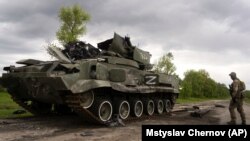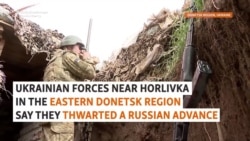More than 260 Ukrainian soldiers were evacuated on May 16 from Azovstal, the steelworks in the southeastern Ukrainian port city of Mariupol that has been under siege for weeks.
The Ukrainian Defense Ministry announced the evacuation after one of the commanders of the Azov Battalion, the Ukrainian military unit that has been holed up in the steelworks, signaled a possible end to the siege.
Live Briefing: Russia's Invasion Of Ukraine
RFE/RL's Ukraine Live Briefing gives you the latest developments on Russia's invasion, Western military aid, the plight of civilians, and territorial control maps. For all of RFE/RL's coverage of the war, click here.
Ukrainian Deputy Defense Minister Hanna Malyar said 53 "heavily wounded" soldiers were taken to a hospital in Novoazovsk, while another 211 others were evacuated through a humanitarian corridor to another site.
The Azov Battalion announced earlier on social media that in order to save lives "the entire Mariupol garrison is implementing the approved decision of the Supreme Military Command and hopes for the support of the Ukrainian people."
Azov Battalion commander Lieutenant Colonel Denis Prokopenko said in an accompanying video that the decision was "the highest level of overseeing troops, all the more so when your decision is endorsed by the highest military command."
The Russian Defense Ministry earlier announced an agreement for the wounded to leave the steelworks for treatment in a town held by Moscow-backed separatists. The ministry said a cease-fire had been introduced in the area of the plant and a humanitarian corridor opened, according to TASS.
There was no word on whether the wounded would be considered prisoners of war.
The Russian Defense Ministry said a cease-fire had been introduced in the area of the plant and a humanitarian corridor had been opened, according to TASS, quoting the ministry. It said Ukrainian soldiers were being taken to a medical facility in Novoazovsk.
The news came amid a renewed Russian assault in the east in which at least 19 civilians were killed, officials in the region said.
Serhiy Hayday, the governor of the Luhansk region, said 10 civilians were killed in Severodonetsk after saying earlier that heavy shelling had caused fires in residential areas. Another nine civilians were killed in the Donetsk region, regional Governor Pavlo Kyrylenko said on Telegram.
The renewed Russian assault in the east came as NATO said that Moscow's invasion was not going to plan and its push to capture the Donbas region had ground to a halt.
President Volodymyr Zelenskiy said in his nightly address late on May 15 that Ukrainian forces were "preparing for new attempts by Russia to attack in Donbas, to somehow intensify its movement in the south of Ukraine."
"The occupiers still do not want to admit that they are in a dead end and their so-called 'special operation' has already gone bankrupt," he added.
Meanwhile, Ukraine's military said its counterattack around Kharkiv, the country's second-largest city, gained momentum and its forces pushed Russian troops back to the border in the region around Kharkiv.
"The 227th Battalion of the 127th Brigade of the Territorial Defense Forces of the Kharkiv armed forces drove out the Russians and went to the state border," the Ukrainian Defense Ministry said in a statement posted on Facebook on May 16.
Presidential adviser Oleksiy Arestovych said Russian troops were being transferred in the direction of Donbas after withdrawing from Kharkiv following the Ukrainian counteroffensive.
Ukraine's claims could not be immediately verified.
Earlier, Ukrainian Defense Minister Oleksiy Reznikov said he and U.S. Secretary of Defense Lloyd Austin had discussed the situation on the battlefield and Austin's call last week with the Russian defense minister.
Reznikov told Austin how Ukrainian forces were successfully using 155-millimeter howitzers sent by the United States.
Ukraine has deployed many of the newly received U.S. howitzers at the front lines, and Washington has delivered all but one of the 90 artillery pieces they were due to send, the U.S. Embassy in Kyiv said.
In Estonia, NATO is due to kick off some of the largest-ever exercises later on May 16. The scheduled exercise, code-named Hedgehog, will last two weeks and involve 15,000 troops from 10 countries, including Britain, the United States, and nonmembers Finland and Sweden.
Sweden on May 16 officially announced it will apply for NATO membership as a deterrent against Russian aggression. The announcement came a day after Finland announced that it was seeking to join the alliance.
Russia on May 16 again warned that the admission of the two Nordic neighbors into the alliance would be a "grave mistake" that would have "far-reaching consequences."
In Brussels, foreign ministers from the 27-member European Union failed to reach a breakthrough on new sanctions on Russia at a meeting in Brussels on May 16 as Hungary continued to block a ban on Russian oil imports.
Talks between ministers "clarified some issues" but no agreement was possible, EU foreign policy chief Josep Borrell said at a press conference after the meeting.
Borrell said that representatives of the EU member states had returned to technical negotiations.
Hungary, a country heavily dependent on Russian oil, has been refusing to agree to the oil ban, demanding far-reaching concessions.
Arriving for the meeting, Ukrainian Foreign Minister Dmytro Kuleba said the EU continues "to finance the Russian war machine, its aggression and atrocities" with its energy imports.
Referring to an ongoing stalemate over a potential EU ban on Russian oil imports, Kuleba said, "We are all curious to see how this saga ends."
As he left the talks Kuleba urged the EU to send a message to Hungary to move the package forward.


















